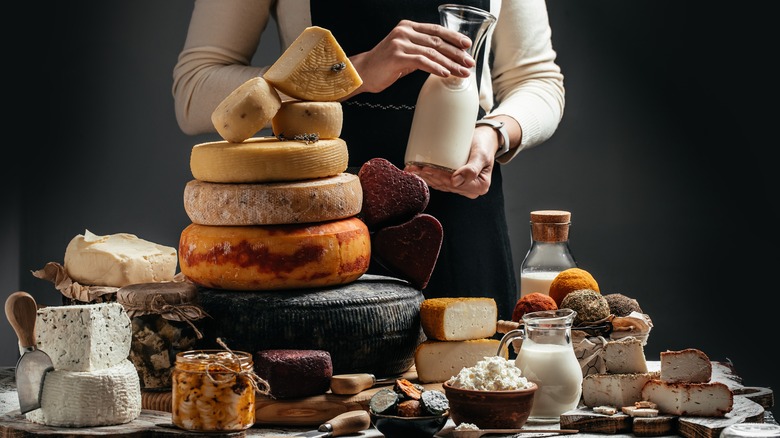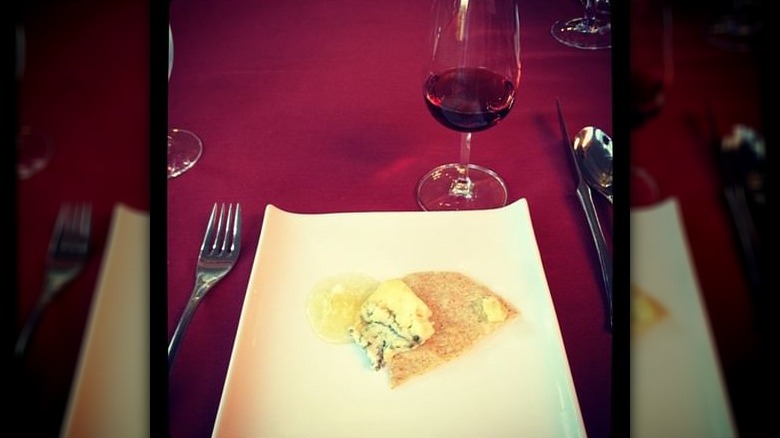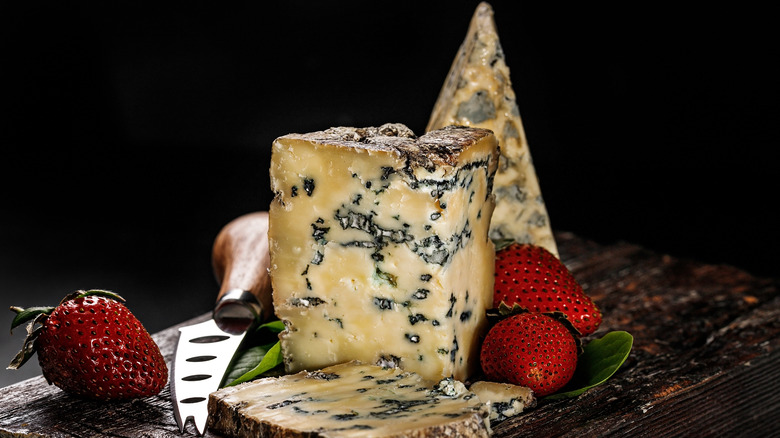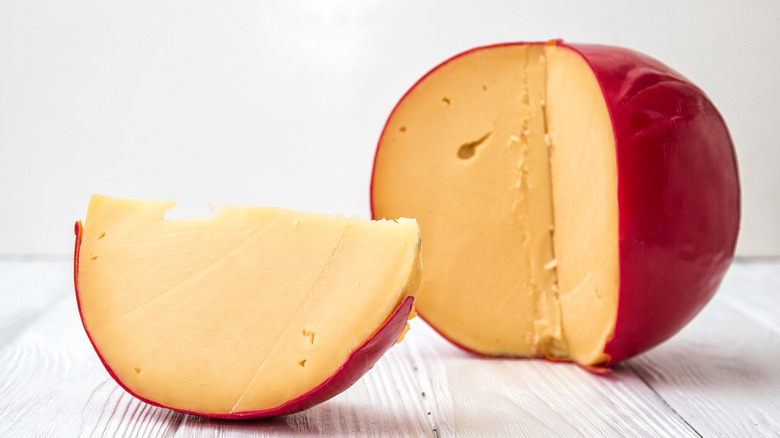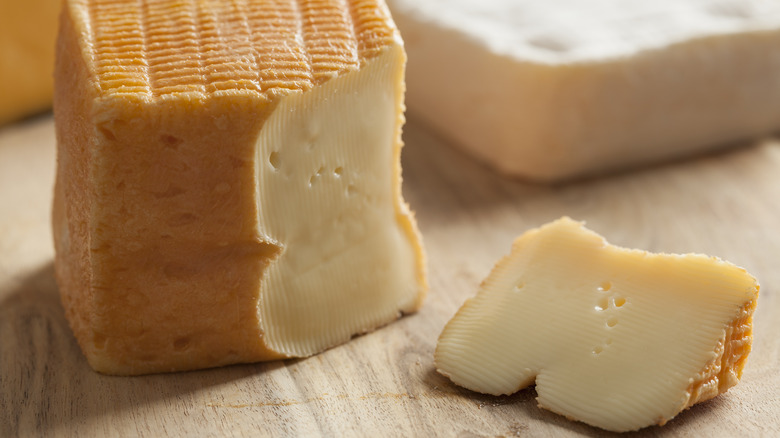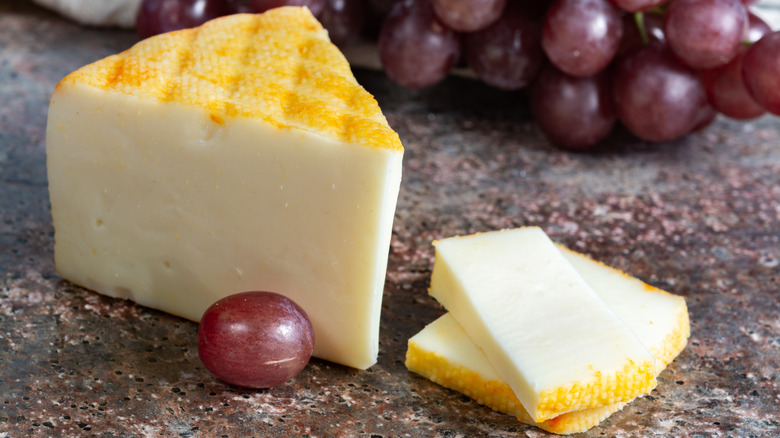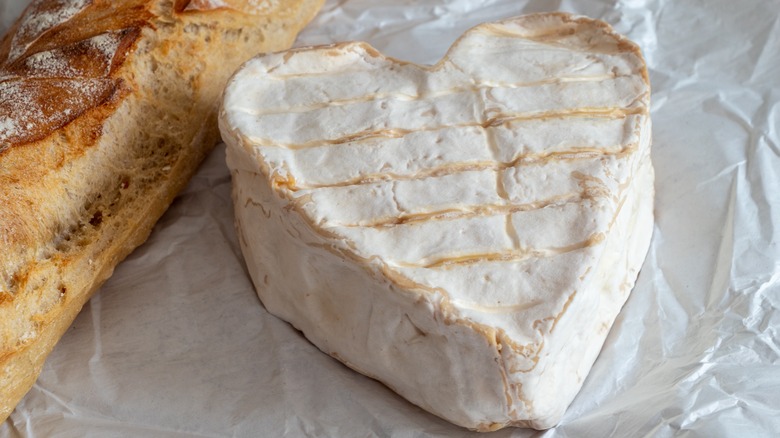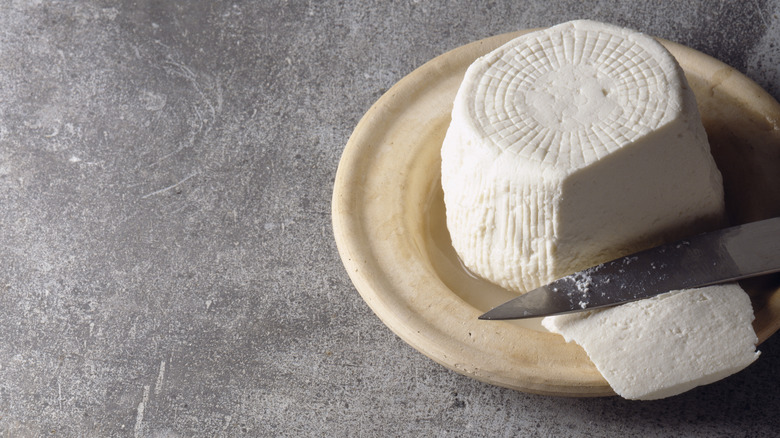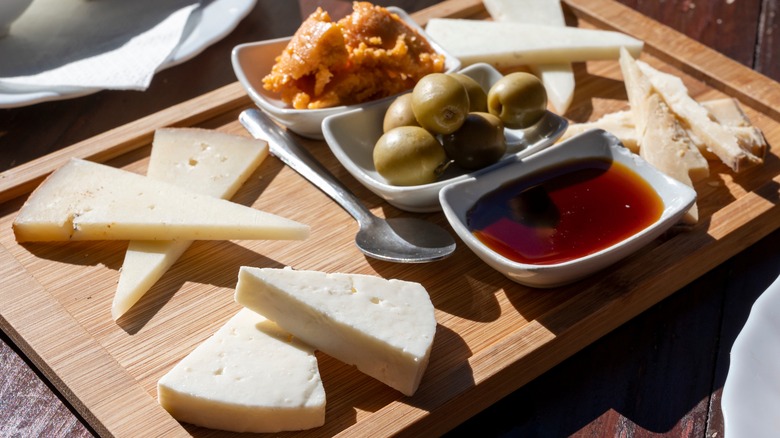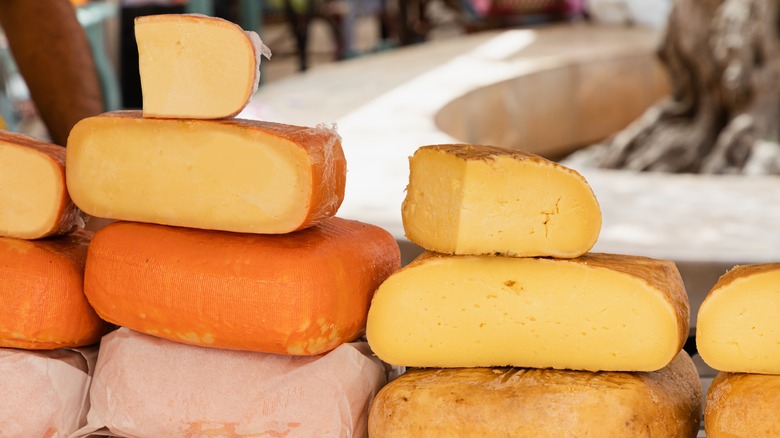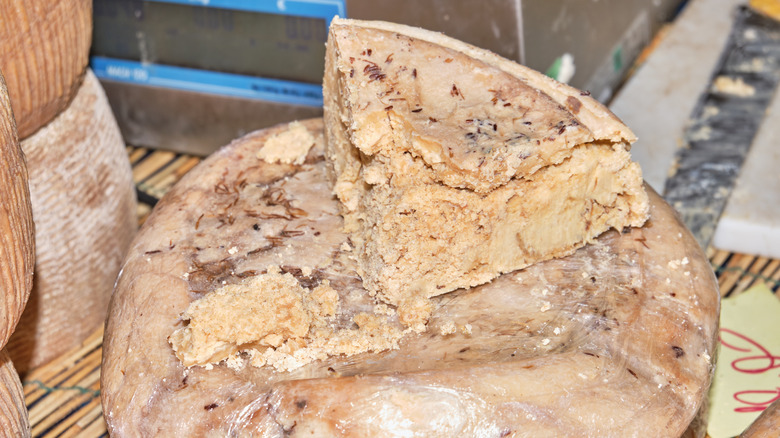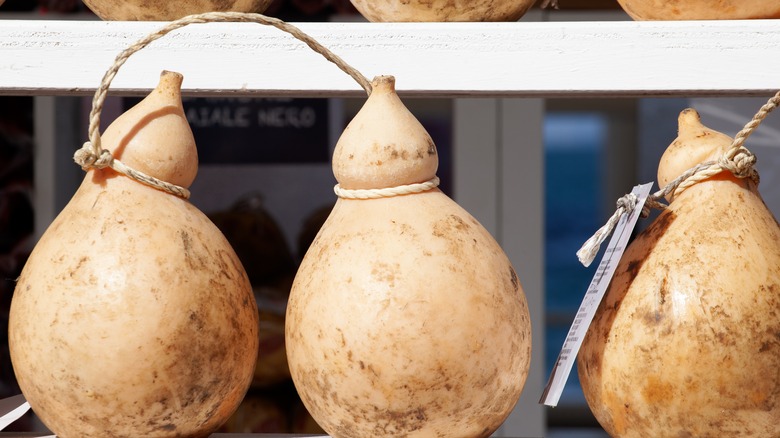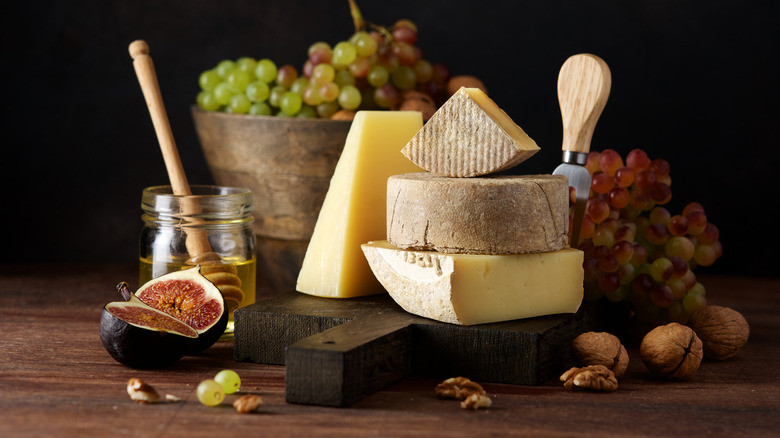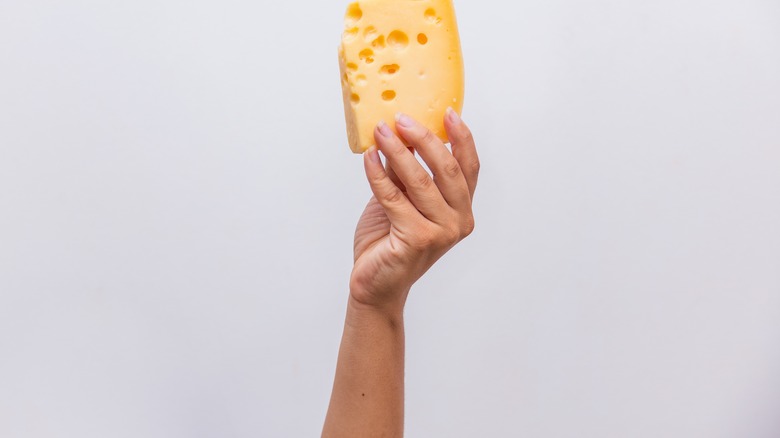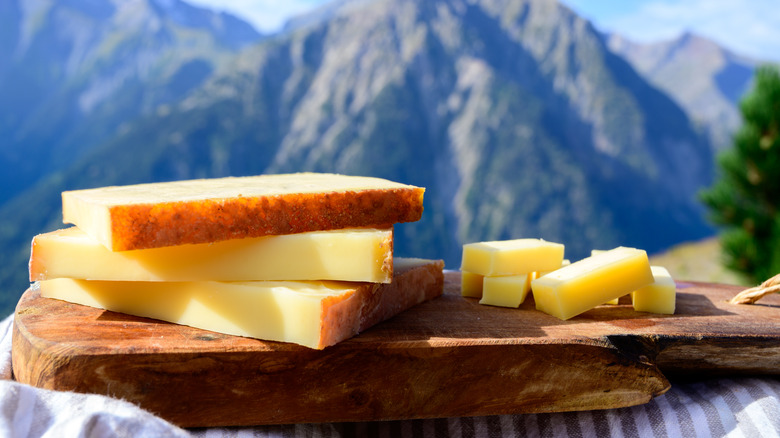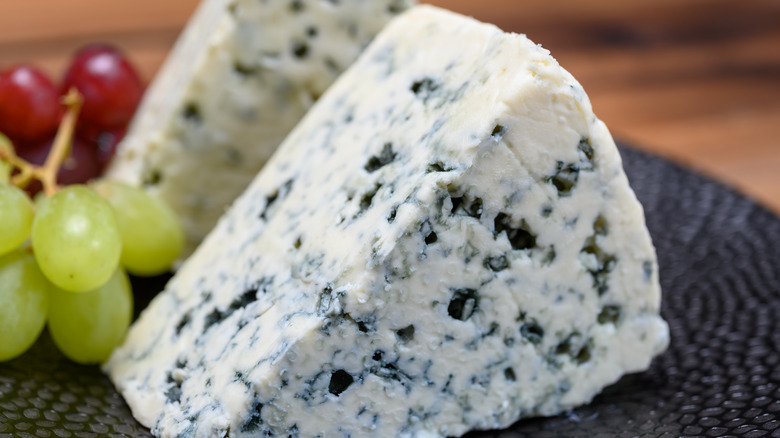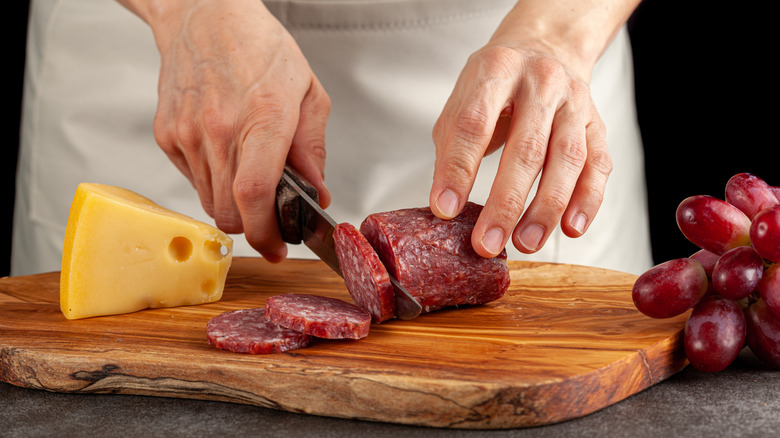17 Different European Cheeses You Need To Try At Least Once
Hard, soft, aromatic, mild, crumbly, smooth, aged, or fresh: the world of cheese is vast, beautiful, tasty, and sometimes stinky. Cheese is the stuff of charcuterie boards, dinner parties, and fancy restaurants. In that image, Europe has become synonymous with cheese: creamy Bries, orange cheddar, and tangy feta are only some of what the continent has to offer.
But, Europe isn't necessarily the homeland of cheese. A two-part article from The Cheese Grotto traces the history of the beloved good back to the Fertile Crescent (a region in Southwest Asia) where cheese-makers got their start with goats and sheep. As humans migrated to Europe, they brought their cheese-making ways with them. In Europe, cheese made its way, allegedly, through the Mediterranean, where it then spread throughout the half continent (via The Cheese Grotto). It's also worth mentioning that the settlement of North African Muslims on the Iberian Peninsula was also responsible for the import of cheese and cheese-making equipment to the far-reaches of Western Europe.
The rise of Christianity proved fruitful for cheese, and the milk culture associated with monasteries gave rise to the dairy-based cheese that arguably defines Europe. Over time, cheese continues to hold a presence in Europe. Cheese began to have an ever-increasing regional identity, where each corner of the continent boasted a unique take on the delicacy. That's why nowadays it seems like each country has one, if not many, one-of-a-kind cheeses to whet the palate. Below are 17 cheeses that may not be as familiar, but are worth digging into.
Blue Rathgore
The first cheese on the list is hard to come-by, as it's been out of production for the last decade or so. But, first, let's backtrack and talk about what all the hub-bub is. Blue Rathgore is a unique goat cheese that is defined by Taste Atlas as striking a balance between buttery and spicy. Its texture is both crumbly and extremely creamy; its flesh covered with a blue-green mold that classifies it as a blue cheese. A relatively short ripening period of six months is enough time to bring this intense cheese into fruition. Similar to its ripening process, this cheese has a relatively shorter history. Blue Rathgore was first cultivated in Northern Ireland in the late '80s, and discontinued by the start of the new millennium.
It's safe to say that this artisan cheese strikes a balance, but is in no way a subtler cheese. For cheese connoisseurs who prefer a bolder bite, there is no better introduction. That being said, as mentioned above, this beautiful cheese is no longer produced. Cheese Reference offers a few suggestions for those looking to get into this. Harbourne Blue of the U.K. and Spain's Picos de Europa will give a similar bite, though do keep in mind that Picos de Europa is, unlike the other two cheeses, not vegetarian.
Stilton
Stilton is an English blue cheese and has been referred to by some as the "king of cheeses" (via Delighted Cooking). Stilton is defined, as per the Encyclopedia Britannica, as a cow's milk cheese with a rich and intense flavor. This particular cheese has a semi-soft texture with an ivory to yellow color that is marked with blue and green mold veins that embolden and define the cheese's flavor. Unlike other cheese's on the list, Stilton blue cheese does not have an edible rind.
But, there's one more caveat! As noted by Delighted Cooking, Stilton cheese has a protected origin designation, which means that to be qualified as this particular blue cheese, it needs to meet certain standards. In this case, it also needs to come from one of three counties: Leicestershire, Nottinghamshire, or Derbyshire. Out of these three counties, there are, as noted by Delighted Cooking, only six creameries that are certified to produce Stilton.
There's one more thing to be wary of when it comes to Stilton! In an interview with NPR the Secretary of the British Cheese Board reported that some sleep studies have shown that people who have eaten a relatively small amount of Stilton before bed experienced outlandish dreams. As the secretary joked, it's certainly the stuff of dreams for psychoanalysts. For a bit of sizzle on the palate and the subconscious, this blue cheese may be the perfect nightcap.
Edam
Pale orange cheese covered in bright red wax, there is something iconic about Edam: even if you haven't tasted it, you probably have seen it. Edam is a Dutch cheese that is slightly salty in taste with a slight tang to it (via Cooks Info). This particular style of cheese has been around for ages, and while its iconic red wax seal helped its shelf life, nowadays, it's also come to make Edam easily identifiable, according to the food website. While the red can be seen by a mile a way, other colors can signal certain extra properties to the cheese; black wax, for example, indicates Edam that has been aged up to 17 weeks, while orange means that the cheese has been infused with cumin. Similar to Stilton, Edam cheese has become a protected good as well. "Edam Holland" is for Edam cheese that has been made in Holland under strict guidelines.
Otherwise, the cheese being eaten is "edam-style", which holds the generic qualities that define Edam but is made anywhere in the world. Edam-style cheese is also made from pasteurized milk. The supposed cheese-capital of the U.S., Wisconsin, is one such area that takes a swing at the classic cheese themselves. Of course, the region approaches the classic cheese with a pioneering ingenuity: they take a classic cheese and add a smokey, aged, or organic spin to the long-held favorite (via Wisconsin Cheese).
Limburger
This cheese has a reputation that precedes it: Limburger cheese ranks among the stinkiest of the cheeses (via Cheese House). As one Wisconsin cheese site advises, don't eat this cheese with your nose! While some compare the cheese's stench to that of gym socks, the more romantically inclined describe Limburger as having an earthy aroma that is just as much an experience as all other parts of the cheese eating experience (via NBC15).
This particular cheese originates from the bygone Duchy of Limburg that held control of contemporary Germany, Holland, and Belgium (via Wisconsin Cheese Man). The cheese is ivory white and made from a bacteria that lends to a distinct earthy, yet mushroom-like flavor. The Wisconsin-based cheese site describes three stages in that maturation process of Limburger cheese. Fresh Limburger cheese has a mild feta-like texture, but by the maturation process past four months, Limburger begins to take on a sweaty and runny texture, and of course its signature smell.
The site describes its flavor as bold, yet not as sharp as cheddar or as pungent as blue cheddar. While Limburger cheese is enough of a show on its own, the Wisconsin site describes the cheese as a working man's cheese that historically pairs well with some rye bread, a bratwurst, and of course, a hearty beer or black coffee.
Saint Paulin
Saint Paulin cheese is a cow cheese from a lesser-known region of France: Bretagne, or Brittany, that bears a close cultural tie to Britain. Saint Paulin is a so-called Port du Salut cheese, which means that it is aromatic, slightly stiff, and originally cultivated by Trappist monks of the region (via Cooks Info). Saint Paulin cheese doesn't need a lot of time to develop, it can mature and be ready to enjoy within a mere four to five weeks.
Despite the cheese's firmer texture, the Taste Atlas describes the cheese as extremely creamy, with a slightly milky aroma, and nutty yet buttery taste. Saint Paulin is certainly creamier, it has around 40% fat content on average. Some have compared Saint Paulin to Havarti or Esrom (via Cheese). This particular cheese is perfect for vegetarians, and its milder and buttery texture lends itself well to sharper pairings. Grapes for one, bring out and compliment the milder aspects of the cheese. When in Rome, sit down and have a good drink! Saint Paulin pairs exceptionally well with French red wines like Beaujolais.
Neufchâtel
Be still my heart! The romantically-shaped Neufchatel is said to have first been shaped by the hands of lovelorn French milkmaids during The Hundred Years War as their British soldiers trudged into battle (via Culture Cheese Magazine). The rest is history, as they say! Structurally, Neufchâtel is the same as cream cheese. In fact, cream cheese was said to have come from one New York-based food scientist who sought to recreate the French cheese stateside. Though never quite achieving the perfect knock-off, because of this happy accident, Neufchâtel and cream cheese can still almost be used interchangeably.
It is nonetheless important to keep differences in mind. Neufchâtel, for one, is made out of raw cow's milk, but a lower fat content than cream cheese. The French version is a bit creamier and tangier as well, due to the fact that it does not use cream unlike cream cheese (via Master Class). The French cheese also has a slightly grainier texture. At first glance, the heart-shaped darling may indeed seem a bit closer to another cheese: Camembert or Brie. Similarly, it also has an edible rind. Neufchâtel also has a similar status as other traditional European cheeses; without the appellation d'origine contrôlée, or designation of origin, it's technically not the same heart!
Brocciu
Brocciu is also from France, albeit from the island of Corsica that is a part of the French nation. Similar to Neufchâtel, Brocciu is an amazingly soft cheese. However, unlike the aforementioned cheese, Brocciu is made either from sheep or goat's milk (via Culture Cheese Magazine). The same article asserts that some believe in order to really "taste" the island of Corsica, you need to taste Brocciu. This reflects the island's affinity in the 500 tons of Brocciu that are produced annually or the relatively small island according to the cheese magazine. Brocciu is often compared to ricotta though with a tangier twist. It's sweet yet fragile, and the magazine notes that it's also creamy and sweet. Lactose intolerant friends will be delighted to know that Brocciu offers a dairy-free alternative to its Italian counterpart (via Taste Atlas).
Brocciu really adds to wherever it goes; and with this line of thought, it can be found in seemingly endless pairings. For dessert, it can be eaten with fig jam or coffee, or in beignets and lemon custard. But, the soft cheese does just as well in savory dishes: omelets, stuffed zucchini, and soups also are more than ready to let Brocciu in with welcoming arms.
Canary goat cheese
The Canary Islands, also known as the Canaries, are a chain of islands just off the coast of North Africa, that technically are a part of Spain. Since antiquity, indigenous peoples have herded cattle and goats throughout the islands (via Culture Cheese Magazine). The same magazine notes that in the early modern period, the Canary Islands became an outpost for colonizers traveling West. In short, Europeans brought their cheese sensibilities with them. The presence of herded cattle and goats provided the structure for future cheese-making. Indeed, the influence of Spanish cheese-making practices can still be seen to this day.
For a small island chain, there is still a lot of diversity; each of the 8 Canary Islands holds claim to their own unique recipes and cheeses (via Hello Canary Islands). Nonetheless, generalizations can still be made. The vast majority of Canary Island cheeses are goat cheeses that are smooth, sweet and creamy (via Spanish Fine Cheese). Canary Island goat cheeses do well by themselves, in sandwiches, added to salads or soups. A full-bodied wine will also play really nicely with these milder cheeses. Canary Island goat cheeses are not made for export, most are produced by local farms. As one cheesemaker in the Culture Cheese Magazine is quoted as saying, "If you want to try the cheeses, you'll have to come here." If there's any reason for an island getaway, why not this?
Mahón
Mahón is another Spanish island cheese! From the island of Menorca, Mahón is made from cow's milk and is actually named after the island's capital city, which speaks volumes to its popularity. Cheese of the Month Club has even stated that next to tourism, the cheese industry reigns supreme in the island economy. In fact, in a tale of David and Goliath, Mahón comes up second only to the shadow of the superstar Manchego cheese.
It's at first glance that it becomes completely obvious that this cheese is something completely different from the more laid-back and pale Canary Island goat cheese. It's not just Mahón's color that is vibrant: it has a creamy taste that is cut by a certain sharp spiciness, most likely because the cheese is rubber with butter and paprika oil as it matures (via Cheese). The Cheese of the Club also notes that the cheese has a slightly sweet and fruity aroma that undercuts its spicy nature. Actually, it's common practice to take mature chunks of Mahón and top it with crushed black pepper, tarragon, and olive oil to add layers to the spice. As the site notes, the cheese pairs very nicely with full-bodied wines to make for an indulgent experience.
Casu Marzu
Before recoiling, take a closer look! The Guinness Book of World Records classified this as the world's most dangerous cheese and for obvious reason. Casu marzu, a regional cheese unique to the island of Sardinia is, according to the site, an illegally produced sheep's milk cheese that uses maggots as its special ingredient. Yes, that was read correctly: a maggot infused cheese. Its name means rotten cheese, which sheds light on the process behind the infamous cheese. In end effect, Casu Marzu is a Pecorino cheese that's been left to, in essence, rot. The maggots, which actively process the cheese, eat and pass the cheese, which leads to a unique fermentation process. It's the maggot which not only gives the cheese its taste, but leads to its unique creaminess (via CNN). The danger, according to Guinness, is that maggots when consumed en masse can lead to major stomach complications.
CNN asks, however, that readers turn their alleged disgust in the cheese into a cautious curiosity. At the end of the day, Casu Marzu is a traditional cheese, a culture in its own culture. There's a reason why it's stuck around for so long, and a reason why it's persevered, even if it's not understandable. The site does also make the point of noting that there's a certain eco-friendliness to the small in-house produce of the cheese. Besides, as the news source almost cheekily, points out: there hasn't been a major Casu Marzu injury yet.
Caciocavallo
Nope, not a gourd, Caciocavallo is the cheese that stands alone. Or rather, the cheese that hangs alone. The name caciocavallo translates roughly to "cheese on horseback," which refers to the hanging and drying method that lets this cheese develop its full-bodied flavor and texture that has defined it both on the Italian peninsula and abroad (via Cheese). As the site notes, the cheese has a "profound" taste with intense earthy flavors and aroma, and there's a persistent saltiness to caciocavallo. Caciocavallo can be found in a milky white or vibrant yellow, and can be made from either sheep or cow's milk.
Caciocavallo is a soft cheese with a slightly stringy and elastic texture, according to The Green Truffle. The same site asserts for the health-conscious cheese lover, this Italian beauty is the right way to go. This particular variety is rich in minerals, nutrients, and calcium. Of course, this doesn't mean that a wheel a day will keep the doctor away. Health notes aside, caciocavallo pairs well with pasta, salads, risotto, and antipasti.
Gruyère
When thinking about Swiss cheese, it is probably Gruyère that comes to mind. Its pale skin and tiny holes, technically called eyes, are really the aesthetic look that puts the central European cheeses on the map. Gruyère comes from the town of Gruyères where it also got its name. Gruyère has pale yellow skin with what L'Academie somewhat boldly describes as a "pockmarked" rind. Really these pockmarks are a part of the process, they're the result of air bubbles forming and popping while the cheese is being made, according to another L'Academie article.
In comparison to other Swiss cheeses, Gruyère isn't the holiest of them all. This cheese is made specifically from the unpasteurized milk of free-grazing Swiss cows. While the flesh of Gruyère is creamy, its rind tends to be grainier. This particular cheese tends to sharpen the older it gets, and though it's milder even at its peaks compared to other cheeses on this list, it has what the previously mentioned site describes as pleasant taste. It lends itself well to quiches among other traditional French fare like French onion soup or Croque Monsieur. Of course, Gruyère makes for an especially creamy fondue which is a trademark of Swiss cuisine. Or, without reinventing the wheel, Gruyère makes for a quiet yet formidable presence on the cheese board.
Emmentaler
Emmentaler is another unpasteurized cheese unique to Switzerland; it is semi-hard, with considerably large eyes, and bursting with flavor (via Castello Cheese). Emmentaler is a mountain cheese that is sourced from the famous Swiss cows, as described by Home Cook World. Many foodies credit the Emmentaler's amazing flavor to the fact that not only is its milk unpasteurized, but the milk is sourced from cows that feast only on hay and grass. True Emmentaler cheese actually has no artificial additives of any kind. Nonetheless, it still has interesting notes of hazelnuts and ripe fruit that tickle the tongue long after digging in. This cheese simply makes a bold entrance and holds a bold presence. This cheese is particularly floral in fragrance, with a nutty and buttery flavor to it.
Emmentaler is actually another protected good and for it to truly be Emmentaler cheese, it needs to be produced in Switzerland and undergo strict inspection to be classified as an Emmentaler cheese. This can translate to a pretty hefty price tag (though Emmentaler fanatics swear by it), but cheese from unpasteurized milk is hard to find stateside. Home Cook World offers some suggestions when picking out the cheese, whether under the designated protection or knock-off: the cheese should be yellow in style, have an abundance of holes, and be soft to the touch.
Bergkäse
3Cheese at 1,800 meters up the mountain (via Bald auf Käse)! Bergkäse, known as mountain cheese, is often referred to as the baby brother of Emmentaler cheese (via True Foodies). While just like Emmentaler cheese, it's from the German mountains, albeit from the other side of the border. Bergkäse, sometimes referred to as mountain cheese in English, utilizes a similar approach to grazing and manufacturing this stunning cheese. It's the type of dairy that results from the mountain's cornucopia of herbs and flowers that many speculate gives this cheese its light and astounding aroma. It retains a similar yellow coloring to Emmentaler cheese, but, is much harder and has much smaller holes, as noted by the foodie website. Similar to the Swiss cheese, the German cousin is an artisanal cheese that has earned its product of designated origin label, in fact, Bergkäse is the only PDO in Germany, as of the date of this article.
Bergkäse is a Spring cheese that can mature well over 16 months at a time. It's a hard cheese with a bold flavor and a fat content at a whopping 62%. Perhaps this little brother isn't so little after all! Though both come from the Alpine region, there's certainly enough of both cheeses to keep you coming back for more.
Danalblu
It's been a while since a blue cheese has been mentioned, and there's something about the China blue of the Danalblu, also known as the Danish blue that certainly makes it worth the wait. Castello Cheese praises the scintillating Scandinavian snack as the "quintessence of fine dining," and describes it as an indulgent cheese. It is both creamy, mildly bitter, sharp, salty, and very importantly crumbly. It is, in all senses of the word, a blue cheese. Really, it is everything that makes blue cheese good.
At one point, this particular Danish cheese was made with goat's milk, though this was eventually swapped with cow's milk to give the cheese a smoother and creamier finish (via Cheese). Danalblu is semi-soft and matures over a period of eight to twelve months, where it develops a yellowish rind that is completely safe to eat. However, Danalblu is not a vegetarian-safe cheese, as it contains animal rennet. Nevertheless, both sites suggest pairing luxury with luxury. The latter website suggests to pair the cheese with a full-bodied Cabernet to balance it out, while the former suggests beef or veal, or a rich bowl of pasta.
Jarlsberg
The infamous scene stealer from the Devil Wears Prada, Jarlsberg does more than make $8 (burnt) grilled cheeses (via Medium). After all, there had to be a reason that Nate was so willing to shell out dollars for this creamy golden yellow cheese! But, there's more to this mild cheese than its role in critically acclaimed films — though that is an amazing credit.
It seems that there's some consensus on the subject. Hailing from Norway, Jarlsberg accounts for around 60% of total cheese exports (via Cheese of the Month Club). Jarlsberg is made from cow's milk and semi-soft; it has a bit of chew to it. The Scandinavian cheese has a remarkably nutty taste, and is visually appealing with its bright color and many considerably large holes. The cheese club compares the cheese as having the "consistency, texture, and hole-formation" of Emmentaler cheese, with a sweeter flavor of its own. This particular cheese is best described as "all-purpose;" it does just as well as a slice (in a grilled cheese, anyone?), or in many different recipes that call for cheese (via Cheese). It seems that Jarlsberg is popular — and popular for good reason.
Renost
Reindeer might ring more true for Christmas than it does for snacks, but renost, otherwise known as reindeer cheese, is a major game changer. While perhaps more surprising to those outside of the region, reindeer milk and their byproducts have long been utilized by the indigenous peoples of Finland, the Sami, and in their cuisine (via Slow Food). Reindeer milk is much drier in comparison to cow's milk, and much more calorie-heavy, though for those who are lactose-intolerant will be happy to hear the reindeer milk is extremely low in lactose, according to Alimentarium. Similar to halloumi, when made into cheese, reindeer milk-based cheese squeaks when it's chewed on.
Renost has a very strong flavor and is extremely creamy. In Finland, it is even used and melted into coffee as a sort of coffee creamer. The cheese helps to cut the bitterness of the coffee and makes it all the more filling for those cold winter mornings. Those that are curious to try this Northern Delight will be remiss to hear that the female reindeer produce very little milk, and it tends to spoil quite quickly. For the time being, Renost remains a delicacy reserved for the North.
